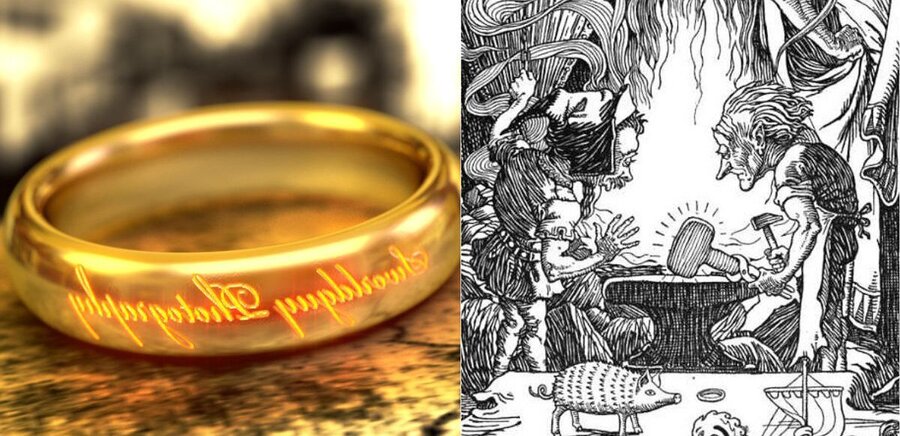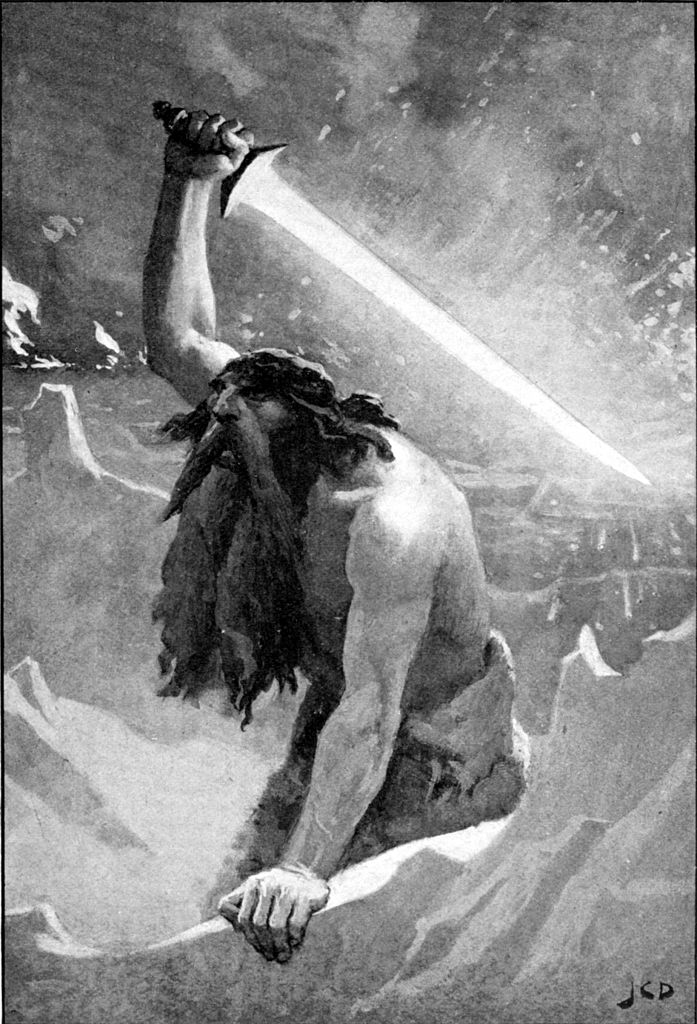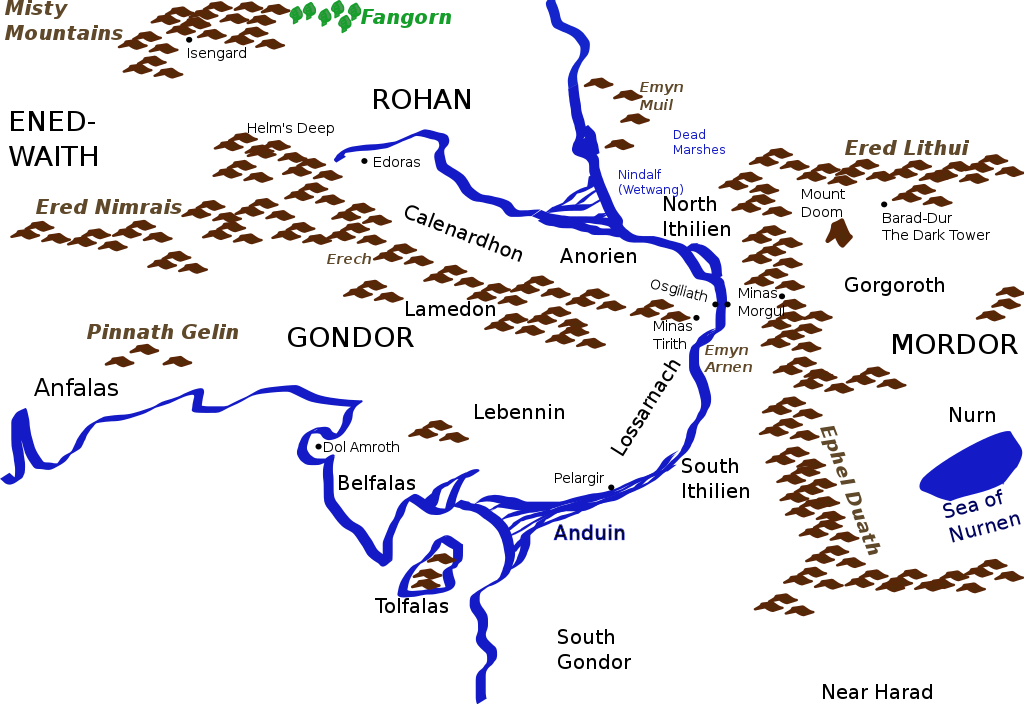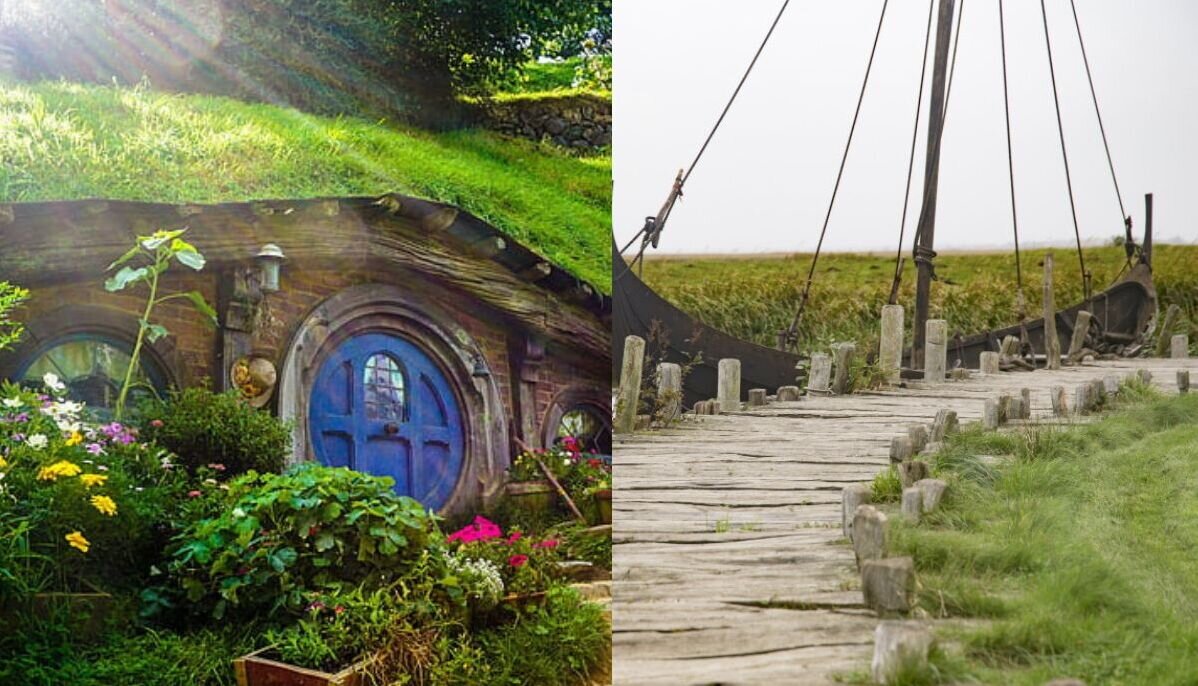Old Norse mythology greatly influenced J. R. R. Tolkien (John Ronald Reuel), the author of The Hobbit and The Lord of the Rings trilogy. His ideas for Middle Earth, the dwarfs (or dwarves in his novels), and the naming of swords and rings all took inspiration from Iceland and its language, myths, landscape, and society.
Tolkien had an Icelandic nanny or au pair from the West Fjords who looked after him during the early 30s when he and his family lived in Oxford, England. Arndís Þorbjarnardóttir introduced Tolkien to the Icelandic language and its mythology and folk tales.
Tolkien was not the only person who found inspiration in Norse mythology. The Völsunga Saga also provided many of the themes present in Richard Wagner’s opera, Der Ring des Nibelungen.
The Norse Myths That Shaped Lord Of The Rings
Swords And Rings
A reforged sword and an all-powerful golden ring are key plot features of the stories and also the main features of Tolkien’s novels.
Rings and swords also frequently appear in the Prose Edda and Poetic Edda. Dwarfs forged the most magical rings, one of which, Draupnir, belonged to the Norse god Odin, while the other, Andvaranaut, originally belonged to Andvari.
Andvari seems to have much in common with Smeagol (Gollum) as they both live by the water and possess a magical golden ring.

The Use of Kennings
Tolkien liked to give inanimate objects names, especially swords and rings (yes, them again!).
The sword that Bilbo passed on to Frodo was called “Sting,” and the “one ring” was known as the Ruling Ring or “Isildur’s Bane.” Isildur’s Bane is a clear example of Tolkien adopting “kenning” in his tales.
Kenning is the Norse Skaldic poetry equivalent of an adjectival phrase used as an alternative name to a god or weapon.
Creatures
The giant, mountain-dwelling creatures from Viking mythology called “trolls” also appear in works by Tolkien. Bilbo Baggins has a memorable encounter with them in The Hobbit.
Elves
Elves feature heavily in Tolkien’s works. However, they do not appear very often in Norse mythology. They do not have an origin story and are divided into Ljósálfar (“Light Elves”) and Dökkálfar (“Dark Elves”), i.e., good and evil.
Tolkien’s elven characters do not share that distinction.
Dwarves
Dwarfs do frequently appear in both “worlds.” Indeed, many dwarf names in The Hobbit also appear in the Prose Edda and Völuspá, such as Bifur, Bofur, Bombur, Dwalin, and Thorin Oakenshield). In addition, Durin was the eldest of the Seven Dwarf Fathers in Tolkien’s works, while Durinn was a dwarf in Norse mythology.
They are characterized as master smiths, living in the mountains and renowned for their insular behavior.
Tolkien favored the plural “dwarves” instead of the previously more commonly used “dwarfs.”
Humans
Wizards and witches are not named as such in Norse mythology. Magic is very commonly used, by Odin, for example, in his enchanting of the head of Mímir to continue providing his words of wisdom. Practitioners of the magic art called “seiðr” were usually female and known as “völva.”
Just as Tolkien’s novels do not feature gods like Odin, Thor, or Loki, Norse mythology does not use wizards like Gandalf or Saruman.
Love-troubled male heroes are common in both worlds, with Sigurd and Aragorn being the best examples.
Female Characters
Strong and independent female figures are common in Norse mythology and Tolkien’s novels, although maybe more prevalent in Norse mythology where Frigg, Freyja, and Brynhild are major characters.
None is as powerful as Galadriel, as Éowyn and Arwen don’t have the same consistently high profile. However, Éowyn does kill a ringwraith and its fellbeast, and Arwen gives Frodo a magical jewel to heal his wounds.
Evil figures
In terms of evil figures in Norse mythology, Loki is responsible for most of those, although he is no Sauron (a hugely powerful malevolent force in the books).
Loki and the fire giant, Surtr, lead the forces of darkness during Ragnarök. The giants are the closest thing to the orcs in Norse mythology because they are the most constant malign presence in their cosmology.
Surtr, in fact, could have inspired the huge fire-demon Balrog. However fearsome as Balrog was, descriptions of Surtr paint him as a larger and more powerful character.

Mythical Beasts
Both worlds feature dragons. The epic tale of Fáfnir and Sigurd compares nicely to Bilbo’s struggle against Smaug in The Hobbit. However, Norse dragons are not portrayed as being the mighty and practically invincible creatures they are in Tolkien’s world.
Huge wolves appear in both canons: Fenrir and Garm in Norse mythology and the wargs in Tolkien’s world.
Similarities And Differences Between Norse Mythology and Tolkien’s World
Flying ability
One of the major differences between the two worlds is the ability to fly of some Old Norse creatures.
Thor’s goats, Tanngrisnir and Tanngnjóstr, pull his chariot through the skies. Sleipnir, Odin’s horse, can fly, as can the gods Sol and Mani and, presumably, the wolves Skoll and Hati, who are prophecized to catch them.
In Tolkien’s world, only creatures with wings meant to fly, such as eagles or fellbeasts, actually fly.

Shapeshifting
Shapeshifting is common to the two lores. Another work by Tolkien, The Silmarillion, describes how Sauron can take the form of a werewolf. In The Hobbit, Beorn turns himself into a savage bear.
In Norse mythology, Loki and Odin can both shapeshift. Loki turns himself into a fly and a salmon, and Odin transforms into a snake.
Similar to shapeshifting is the ability to pass unrecognized while in disguise. It is insinuated that Gandalf does this while traveling around Middle Earth. Odin does it frequently and even has aliases such as Hár.
So many of Odin’s tales involve him traveling around the nine realms concealing his identity that similar characters from other books, like Gandalf, can be described as “Odinic Wanderers.”
Geographical Features
Asgard is always depicted as a large fortified city and would appear similar in style to Minas Tirith or Osgiliath, the capital of Gondor.
However, Asgard was the most important city in the nine realms of Norse mythology and was probably grander than either of them.

The gods
The Legendarium is a complete compendium of J.R.R. Tolkien’s works. It contains his imaginary world of Arda.
The Valar were god-like beings who lived on Aman, a westerly continent of Arda. A parallel could be drawn between them and the Æsir.
Tolkien’s Beliefs And Similar Literature Contemporaries
Tolkien was an Anglo-Saxon professor at Pembroke College from 1925 to 1945. Beowulf and other Old English literature were important influences for his later work. He loved Old English and Anglo-Saxon culture and language, and it was said that he rather looked down on everything French or Norman.
He keenly noted how Anglo-Saxons understood the complicated Greek and Christian ideas about reason and logic.
Tolkien invented an alphabet called the Cirth that used Nordic-style runes for the artificial languages his characters used in his book.
The famous author C.S. Lewis was one of Tolkien’s contemporaries. He also created a detailed fantasy world called Narnia for his most famous work, The Lion, The Witch, And The Wardrobe. He and Tolkien knew each other as they were both students at Oxford University.

